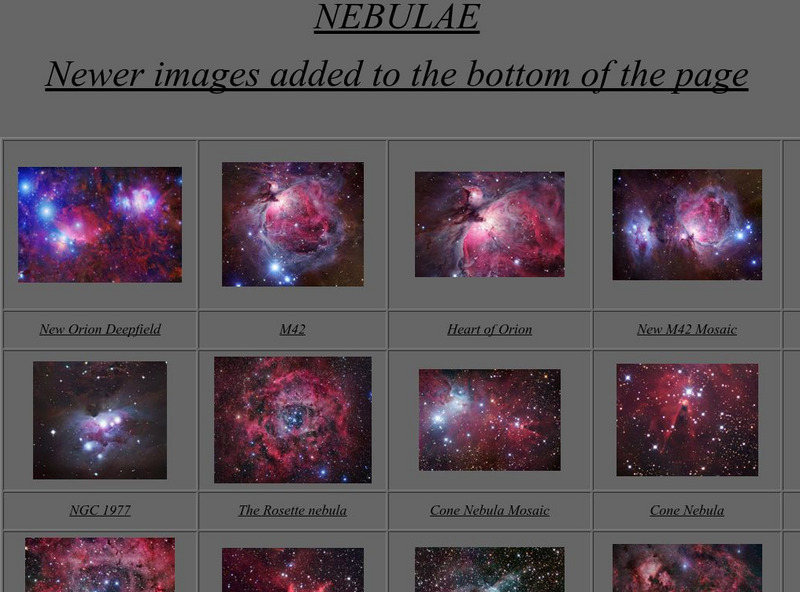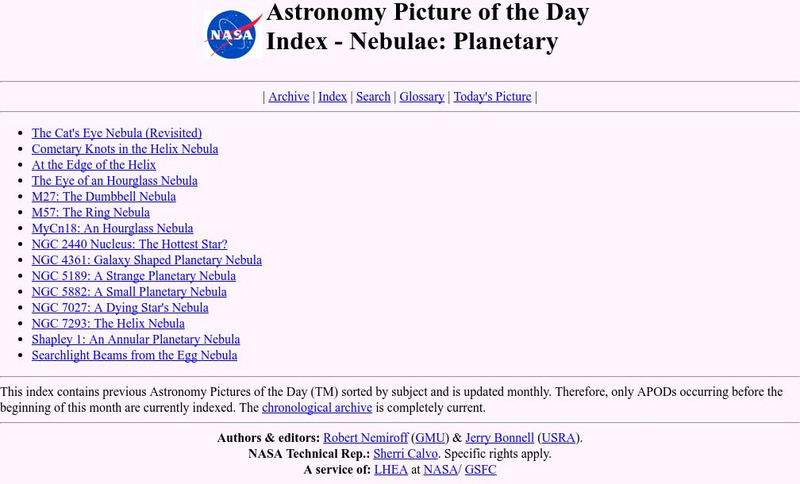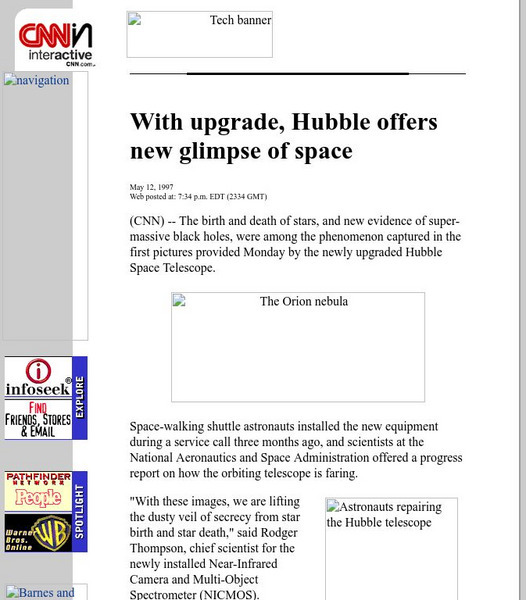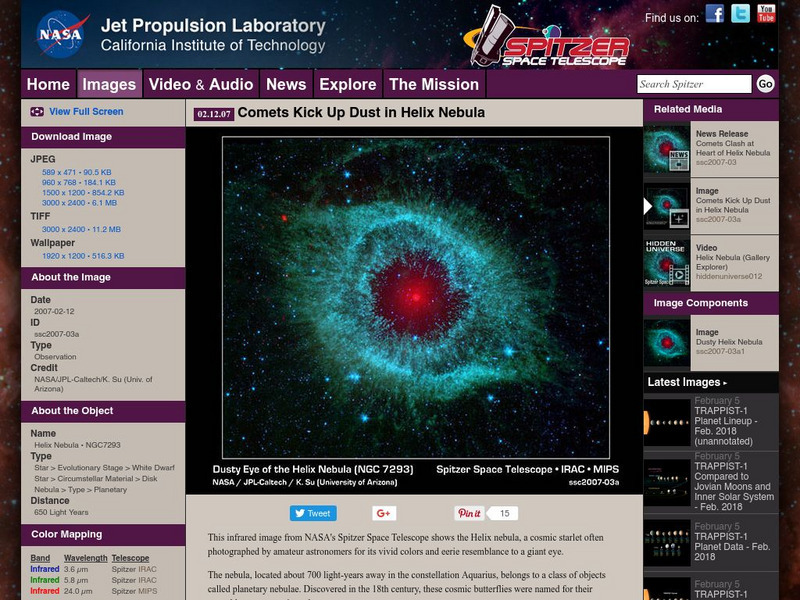Other
Nebulas
Almost 100 images of Nebulas are posted on this amazing site. Magnifications, exposure times, and the name of each nebula are provided.
Other
Nebulas
Almost 100 images of Nebulas are posted on this amazing site. Magnifications, exposure times, and the name of each nebula are provided.
Other
Planetary Nebulae Observer Home Page
This home page is linked to detailed descriptions of nebulae types, shapes, and structures and their relationship to stellar evolution, a historical perspective on the discovery of nebulae, a gallery of images, and other related resources.
NASA
Nasa: Astronomy Picture of the Day: Nebulae Planetary
At this resource several pictures of nebulae are available with informative caption. Related links and other resources.
Other
Cathing the Light: Nebulae Images Thumbnail Index
A colorful look at the various nebulae with these pictures taken by Jerry Lodriguss. Each picture has background information about the nebula.
CK-12 Foundation
Ck 12: Earth Science: Formation of the Sun and Planets
[Free Registration/Login may be required to access all resource tools.] How the Sun and planets formed.
Google
Google Earth: Hubble Telescope
Get a tour of space with images collected from the Hubble telescope. See nebulae, galaxies, and star clusters on this site. Google Earth must be downloaded to use.
Other
Cosmic Wonders: Nebulae
Various different types of nebulae can be explored on this site. View and learn about this stellar phenomena and how they contribute to the growth of the solar system.
Space Telescope Science Institute
Amazing Space: The Star Witness: Hubble Snaps Orion in Perfect Picture Glory
The Orion Nebula is a birthplace for over 3,000 young stars. This article provides a good explanation of this region and some images taken by the Hubble Telescope. (Published Jan. 2006)
CNN
Cnn: Hubble Upgrade
A 1997 CNN report on the results of a repair mission to the Hubble Space Telescope. Video interviews with experts provide information on what the telescope has revealed about several celestial objects (Nebula and Black Holes).
University of Illinois
University of Illinois: Stars and Constellations: Planetary Nebulae
This resource contains information about planetary nebulae and their characteristics.
California Institute of Technology
Spitzer Science Center: Unwrapping the Pillars
Following the title, "Unwrapping the Pillars" this site examines the image containing the pillars of the Eagle Nebula and the reason for their existence. The text is fairly brief but it does provide a basis for understanding the pillars...
California Institute of Technology
Spitzer Science Center: The Infrared Hunter
Under the heading, "The Infrared Hunter" this site examines specific details of an image displaying the Orion nebula along with several other nebulae. In describing the image, the text at this site ends up examining subject matter...
California Institute of Technology
Spitzer Science Center: Towering Infernos
The "Towering Infernos" in the image at this site are actually nebulae or star-forming regions. The text under the image details the specifics of the picture.
California Institute of Technology
Spitzer Science Center: Stellar 'Incubators'
This image, titled "Stellar 'Incubators' Seen Cooking up Stars" features a view of the Trifid Nebula and its star forming capabilities. The text under the image details various specifics about the picture.
California Institute of Technology
Spitzer Science Center: Ring of Stellar Death
The Ring of Stellar Death captured in this space telescope image features a dying star expelling what appears to be clumpy rings of material, but turns out to be part of a planetary nebula. In addition, a detailed textual overview...
California Institute of Technology
Spitzer Science Center: Ring Beholds a Delicate Flower
The Ring Nebula, also known as Messier Object 57, is a dense, star-forming region captured in this space telescope image. In addition, a detailed textual overview explains various specifics of the picture.
California Institute of Technology
Spitzer Science Center: New Views of a Familiar Beauty
The Trifid Nebula, featured in this space telescope image, is seen from four different views. In addition, a detailed textual overview explains various specifics of the picture.
California Institute of Technology
Spitzer Science Center: Helix Nebula
Under the heading, "Comets Kick up Dust in Helix Nebula" this site a particular nebula in the constellation Aquarius. In addition to an image, the site provides information on nebulas and star systems.
California Institute of Technology
Spitzer Science Center: Image of the Tarantula Nebula
The Tarantula Nebula, also known as 30 Doradus, is a dense, star-forming region captured in this space telescope image. In addition, a detailed textual overview explains various specifics of the picture.
California Institute of Technology
Spitzer Science Center: Black Widow Nebula
Under the heading, "Black Widow Nebula Hiding in the Dust" this site examines specific details of an image displaying the Black Widow nebula, which contains clusters of star formation.
California Institute of Technology
Spitzer Science Center: Crab Nebula
This image, titled "Crab Nebula Supernova Remnant" features the Crab Nebula which was noted in the constellation of Taurus by Chinese astronomers. The text under the image details various specifics about the picture.
California Institute of Technology
Spitzer Science Center: All Pillars Point to Eta
This image, titled "All Pillars Point to Eta" features Eta Carinae, which is part of the Carina Nebula and is over 100 times more massive than the sun. The text under the image details various specifics about the picture.
California Institute of Technology
Spitzer Science Center: Double Helix Nebula
The Double Helix Nebula, captured in this space telescope image, features a variety of red giants and red supergiants. In addition, a detailed textual overview explains various specifics of the picture.
























